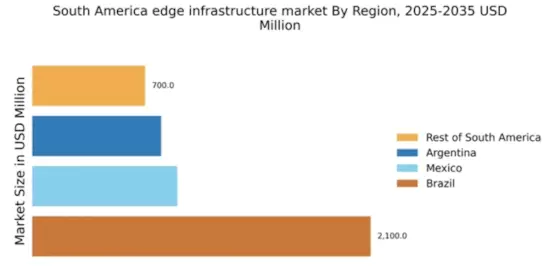Expansion of 5G Networks
The rollout of 5G networks across South America is anticipated to be a major catalyst for the edge infrastructure market. With 5G technology promising higher speeds and lower latency, the demand for edge computing solutions is expected to rise. Analysts suggest that the implementation of 5G could lead to a 30% increase in the need for localized data processing capabilities. This shift towards 5G will likely encourage investments in edge infrastructure, as businesses seek to leverage the enhanced connectivity for applications such as autonomous vehicles and smart cities. Consequently, the edge infrastructure market is poised for growth as it adapts to the requirements of next-generation mobile networks.
Growing Mobile Data Traffic
The surge in mobile data traffic in South America is a pivotal driver for the edge infrastructure market. With the increasing adoption of smartphones and mobile devices, data consumption is projected to rise significantly. Reports indicate that mobile data traffic in the region could grow by over 50% annually, necessitating enhanced edge infrastructure to manage this influx. This growth compels service providers to deploy edge computing solutions closer to users, thereby reducing latency and improving service quality. As a result, the edge infrastructure market is likely to experience substantial growth, driven by the need for efficient data processing and storage solutions that can handle the escalating demand for mobile services.
Increased Focus on Data Privacy
As data privacy concerns continue to escalate in South America, organizations are increasingly prioritizing local data processing to comply with regulations. The edge infrastructure market is likely to benefit from this trend, as businesses seek to minimize data transfer to centralized cloud services. By processing data at the edge, companies can enhance security and ensure compliance with local laws. This shift is particularly relevant in sectors such as finance and healthcare, where sensitive information is handled. The potential for reduced data breaches and improved customer trust may drive investments in edge infrastructure, further propelling market growth.
Rise of Smart Cities Initiatives
The development of smart cities in South America is emerging as a significant driver for the edge infrastructure market. Governments are increasingly investing in technologies that enhance urban living, such as smart traffic management and energy-efficient systems. These initiatives often rely on real-time data processing, which edge infrastructure can provide. It is estimated that investments in smart city projects could reach $100 billion by 2030 in the region. This focus on urban innovation is likely to create a robust demand for edge computing solutions, as they enable efficient data handling and analytics, thereby supporting the overall growth of the edge infrastructure market.
Adoption of Artificial Intelligence Solutions
The growing adoption of artificial intelligence (AI) across various sectors in South America is driving the need for edge infrastructure. AI applications often require substantial computational power and low latency, which edge computing can effectively provide. Industries such as retail, manufacturing, and logistics are increasingly leveraging AI for predictive analytics and automation. It is projected that the AI market in South America could exceed $10 billion by 2026, further emphasizing the need for robust edge infrastructure. This trend indicates that the edge infrastructure market will likely expand as businesses seek to implement AI solutions that demand localized data processing capabilities.


















Leave a Comment